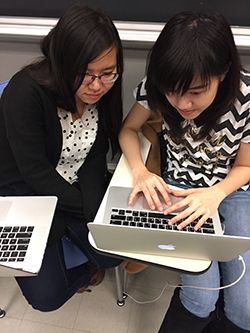In this section, Kyle Keane discusses designed-to-fail projects and how they enable participants to learn, first hand, the importance of working with people that bring different skills to a project. He also shares how failing, on purpose, frees learners to take academic risks and to recover (and benefit) from endeavors that don’t succeed.

Workshop participants complete an online tutorial together.
Designed-to-fail projects are just that: assignments that ask students to do the impossible (like build a video game in six hours as a team, for example). I ask participants to engage in designed-to-fail projects for a few reasons.
First, participants don’t truly understand they need to collaborate with people who bring different skill sets to the work until they fail at a project. And then they realize, too late, for example, that they don’t have a person to manage the graphic assets, and nobody can scramble to do it. It helps drive home the importance of working in groups of people with diverse interests and abilities.
Second, designed-to-fail projects free participants to do things they might consider ridiculous, crazy, or imaginative. If you know the project is not intended to be successful, why not stretch your perceived boundaries?
Students (...) need to fail in supportive classroom environments.
— Kyle Keane
In this way, designed-to-fail projects are in direct contrast to designed-to-succeed projects, where you pick something that you know you're going to be able to do well, because you're going to be judged on the extent to which you succeed at doing what you set out to do. If it's a designed-to-fail project, however, you pick something that's kind of kooky that you want to learn, because no one's going to know that you overstretched your skill set and tried something that was outside of your range. In this workshop, we explicitly allow (and encourage) participants to take these risks.
Finally, I assign infeasible projects because students, in particular, need to fail in supportive classroom environments. They're going to fail whether or not I, as an instructor, give them space to experience failure. Coaching them on designed-to-fail projects allows me to coach them on how to land gently and gracefully, and how to use what they've learned from their failure to inform their future work.
